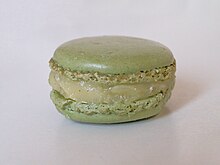Macaron: Difference between revisions
Tag: possible conflict of interest |
|||
| Line 48: | Line 48: | ||
* [http://www.seriouseats.com/recipes/2007/10/how-to-make-macarons-recipe.html How to make Macarons] |
* [http://www.seriouseats.com/recipes/2007/10/how-to-make-macarons-recipe.html How to make Macarons] |
||
* [http://www.petitesbouchees.com/aboutus/macaron.php Petites Bouchées: How to Eat a Macaron] |
* [http://www.petitesbouchees.com/aboutus/macaron.php Petites Bouchées: How to Eat a Macaron] |
||
* [http://manstouch.blogspot.com/2009/10/greatest-temple-of-macarons-in-paris.html Laduree's Macaron Temple of Temptation] |
|||
{{Commons category|Macaron}} |
{{Commons category|Macaron}} |
||
Revision as of 17:30, 19 August 2010



A macaron is a sweet confectionery. Its name is derived from an Italian word "maccarone" or "maccherone". This word is itself derived from ammaccare, meaning crush or beat, used here in reference to the almond paste which is the principal ingredient.[1] It is meringue-based: made from a mixture of egg whites, almond flour, and both granulated and confectionery sugar.
The confectionery is characterized by its smooth, domed top, ruffled circumference, and flat base. Connoisseurs prize a delicate, egg shell-like crust that yields to a moist and airy interior. The French macaron differs from macaroons in that it is filled with cream or butter like a sandwich cookie, and can be found in a wider variety of flavors that range from the traditional (raspberry, chocolate) to the exotic (truffle, matcha tea).[2]
History
Although predominantly a French confection, there has been much debate about its origins. Larousse Gastronomique cites the macaron as being created in 791 in a convent near Cormery. Some have traced its French debut back to the arrival of Catherine de' Medici's Italian pastry chefs whom she brought with her in 1533 upon marrying Henry II.[3]
In the 1830s, macarons were served two-by-two with the addition of jams, liqueurs, and spices. The macaron as it is known today was called the "Gerbet" or the "Paris macaron" and is the creation of Pierre Desfontaines of the French pâtisserie Ladurée,[4] composed of two almond meringue discs filled with a layer of buttercream, jam, or ganache filling.[5][6]
Variations
French regional variations
Several French cities and regions claim long histories and variations, notably Lorraine (Nancy and Boulay), Basque Country (Saint-Jean-de-Luz), Saint-Emilion, Amiens, Montmorillon, Le Dorat, Sault, Cormery and Joyeuse.
The city of Amiens' macaron consists of almond, fruit and honey, and dates back to 16th century. They are chewier and not as sweet as the Paris macaron.[7]
The city of Montmorillon is well known for its macarons and has a museum dedicated to it.[8] The Maison Rannou-Métivier is the oldest macaron bakery in Montmorillon, dating back to 1920.[9] The traditional recipe for Montmorillon macarons remains unchanged for over 150 years.
The town of Nancy in the Lorraine region has a storied history with the macaron. It is said that the abbess of Remiremont founded an order of nuns called the "Dames du Saint-Sacrement" with strict dietary rules prohibiting the consumption of meat. Two nuns, Sisters Marguerite and Marie-Elisabeth are credited with creating the Nancy macaron to fit their dietary requirements. They became known as the 'Macaron Sisters' (Les Soeurs Macarons). In 1952, the city of Nancy honored them by giving their name to the Rue de la Hache, where the macaron was invented.[10]
Switzerland
In Switzerland the Luxemburgerli (also Luxembourger) is similar to a French macaron but is said to be lighter and more airy in consistency.[11]
Japan
Macarons are very popular in Japan where they are known as "makaron"[12]. There is also a version of the same name which substitutes peanut flour for almond and is flavored in wagashi style, widely available in Sendai, Japan.
Popularity
In Paris, the tea house Laduree is highly esteemed for making exceptional quality macarons in traditional and creative flavors. Other French patisseries such as Pierre Hermé and Fauchon are well known for their macarons as well.[13][14] Outside of Europe, the pastry has attracted itself to mostly cosmopolitan cities, notably New York, Hong Kong, Singapore, Sydney, Tokyo, and Toronto.[15] New York has recently witnessed a surge in macaron shops and those wishing to indulge in the delicacy can find a list of sellers in the New York Social Diary.[16][17]
Media
The idea of "Pretty Patties" in the show SpongeBob SquarePants, Season 2, Episode 5 Patty Hype came from this delicacy. [citation needed]
References
- ^ http://www.etymonline.com/index.php?term=macaroon
- ^ http://seattletimes.nwsource.com/html/pacificnw/2010071487_pacificptaste25.html
- ^ http://www.madmacnyc.com/history-of-macarons
- ^ The story of the Macaron
- ^ http://www.laduree.fr/public_en/historique/histoire_macaron.htm.plus.htm
- ^ http://www.foxnews.com/story/0,2933,578089,00.html
- ^ Macarons d’Amiens
- ^ http://www.museedumacaron.com/musee_gourmand.htm
- ^ http://www.rannou-metivier.com/macarons/contenu.html
- ^ http://www.achat-nancy.com/pro19-Notre-Histoire-MAISON-DES-SOEURS-MACARONS.htm
- ^ http://www.spruengli.ch/spruengli/geschenkideen-geschichte-luxemburgerli.php
- ^ http://shinbashiame.com/wp/index.php?s=%E6%92%AE%E3%81%A3&paged=1
- ^ http://www.pierreherme.com/content/FR/EN/boutiques/index.cgi?cwsid=2833phAC194316ph3743430
- ^ http://seattletimes.nwsource.com/html/pacificnw/2010071487_pacificptaste25.html
- ^ French macarons are sweet, light and luscious
- ^ Macaron Hunting in NYC
- ^ Macaron Cafe NYC
External links
- Le Macaron Artisan (Dutch)
- How to make French Macarons
- Panna Dolce - A Fresh Take on French Macarons
- How to make Macarons
- Petites Bouchées: How to Eat a Macaron
- Laduree's Macaron Temple of Temptation
